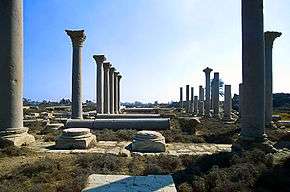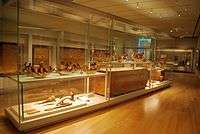Hermopolis
 Hermopolis | |
 Shown within Egypt | |
| Location | El Ashmunein, Minya Governorate, Egypt |
|---|---|
| Region | Upper Egypt |
| Coordinates | 27°46′53″N 30°48′14″E / 27.78139°N 30.80389°ECoordinates: 27°46′53″N 30°48′14″E / 27.78139°N 30.80389°E |
| Type | Settlement |
| Site notes | |
| Condition | In ruins |

Hermopolis Magna or simply Hermopolis[1] or Hermopolis Megale (Greek: Ἑρμοῦ πόλις μεγάλη[2]) or Hermupolis[3] is the site of ancient Khmun, and is located near the modern Egyptian town of El Ashmunein (from Coptic: Ϣⲙⲟⲩⲛⲉⲓⲛ Shmounein) in Al Minya governorate.
Etymology
Khmun, the Ancient Egyptian name of the city,[4] means "eight-town", after the Ogdoad, a group of eight deities who represented the world before creation. The name survived into Coptic as Ϣⲙⲟⲩⲛⲉⲓⲛ (Shmounein), from which the modern name, El Ashmunein, is derived. In Greek, the city was called Hermopolis, after Hermes, whom the Greeks identified with Thoth, because the city was the main cult centre of Thoth, the god of magic, healing and wisdom, and the patron of scribes. Thoth was associated in the same way with the Semitic Eshmun. Inscriptions at the temple call the god "The Lord of Eshmun".[5]
History

The city was the capital of the Hare nome (the fifteenth Nome of Upper Egypt) in the Heptanomis. Hermopolis stood on the borders of Upper and Lower Egypt, and, for many ages, the Thebaïd or upper country extended much further to the north than in more recent periods. As the border town, Hermopolis was a place of great resort and opulence, ranking second to Thebes alone. A little to south of the city was the castle of Hermopolis, at which point the river craft from the upper country paid toll (Ἑρμοπολιτάνη φυλακή, Strabo xvii. p. 813; Ptol. loc. cit.; the Bahr Jusuf in Arabic). The grottos of Beni Hasan, near Antinopolis, upon the opposite bank of the Nile, were the common cemetery of the Hermopolitans, for, although the river divided the city from its necropolis, yet, from the wide curve of the western hills at this point, it was easier to ferry the dead over the water than to transport them by land to the hills. The principal deities worshipped at Hermopolis were Typhôn and Thoth. Typhon was represented by a hippopotamus, on which sat a hawk fighting with a serpent. (Plut. Is. et Osir, p. 371, D.) Thoth, whom the Ancient Greeks associated with Hermes because they were both gods of magic and writing, was represented by the Ibis.
Hermopolis comparatively escaped the frequent wars which, in the decline both of the Pharaonic and Roman eras, devastated the Heptanomis; but, on the other hand, its structures have undergone severe changes under its Muslim rulers, who have burned its stones for lime or carried them away for building materials. A surviving Oxyrhynchus Papyrus of the 3rd century AD indicates that high-rise buildings with seven stories existed in the town.[6]
The city is still a titular diocese in the Roman Catholic Church,[7] and in the Coptic Orthodox Church.
Structures
The town is in a ruinous state. However, some important ruins remain. The Ibis-headed god, was, with his accompanying emblems, the Ibis and the Cynocephalus or ape, the most conspicuous among the sculptures upon the great portico of the temple of Hermopolis. His designation in inscriptions was "The Lord of Eshmoon". This portico was a work of the Pharaonic era, but the erections of the Ptolemies at Hermopolis were on a scale of great extent and magnificence, and, although raised by Greek monarchs, are essentially Egyptian in their conception and execution. The portico, the only remnant of the temple, consists of a double row of pillars, six in each row. The architraves are formed of five stones; each passes from the centre of one pillar to that of the next, according to a well-known usage with Egyptian builders. The intercolumnation of the centre pillars is wider than that of the others; and the stone over the centre is twenty-five feet and six inches long. These columns were painted yellow, red, and blue in alternate bands. There is also a peculiarity in the pillars of the Hermopolitan portico peculiar to themselves, or, at least, discovered only again in the temple of Gournou. (Dénon, L'Egypte, plate 41.) Instead of being formed of large masses placed horizontally above each other, they are composed of irregular pieces, so artfully adjusted that it is difficult to detect the lines of junction. The bases of these columns represent the lower leaves of the lotus; next come a number of concentric rings, like the hoops of a cask; and above these the pillars appear like bunches of reeds held together by horizontal bonds. Including the capital, each column is about 40 feet high; the greatest circumference is about 28½ feet, about five feet from the ground, for they diminish in thickness both towards the base and towards the capital. The widest part of the intercolumnation is 17 feet; the other pillars are 13 feet apart.
Museum
Currently there is a small open-air museum in which stand two massive statues of Thoth as a baboon worshipping the sun, and a few carved blocks of masonry.
Famous people from Hermopolis Magna
References
- ↑ (Ammianus Marcellinus, II 16)
- ↑ Steph. B. s.v.; Ptol. IV 5. § 60
- ↑ (It. Anton. pp 154, seq.)
- ↑ Ian Shaw & Paul Nicholson, The Dictionary of Ancient Egypt, British Museum Press, 1995. p.125
- ↑ Smith's Dictionary of Greek and Roman Geography
- ↑ Papyrus Oxyrhynchus 2719, in: Katja Lembke, Cäcilia Fluck, Günter Vittmann: Ägyptens späte Blüte. Die Römer am Nil, Mainz 2004, ISBN 3-8053-3276-9, p.29
- ↑
 "Hermopolis Magna". Catholic Encyclopedia. New York: Robert Appleton Company. 1913.
"Hermopolis Magna". Catholic Encyclopedia. New York: Robert Appleton Company. 1913.
External links
- Silhouette of Hermopolis Magna temple-from A History Of Egypt Volume V by J Graflon Milne retrieved 20:34GMT 27.9.11